Succulents have gained popularity for their lush foliage and ease of care, making them a favorite among both seasoned gardeners and beginners.
These hardy plants are often touted as virtually indestructible, but this doesn’t mean they require no attention at all. In fact, ensuring the health and longevity of succulents starts with proper potting.
A common misconception is that they thrive in any conditions due to their hardy nature; however, the truth is they can succumb to several succulent potting mistakes that beginners may not be aware of.
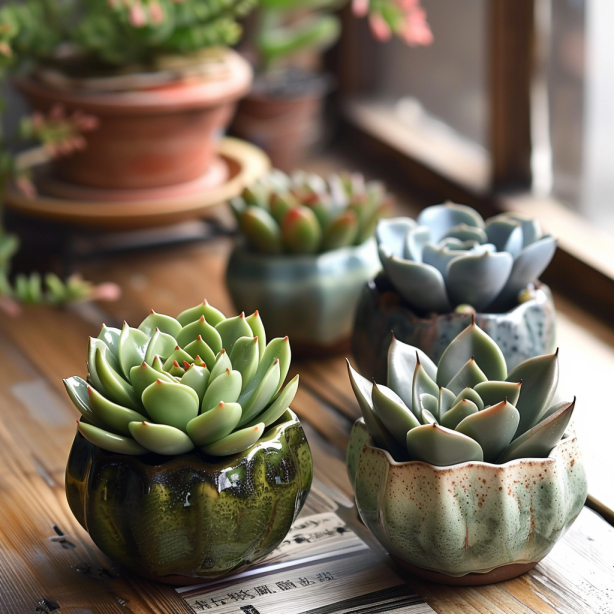
When embarking on the journey of growing these resilient plants, it’s crucial to understand the basic needs and the common pitfalls to avoid.
Overwatering is one such pitfall, leading to the most prevalent problem of root rot. The belief that succulents, like many other plants, need frequent watering is a common error. They store water in their leaves or stems, which allows them to go longer periods without water, particularly compared to other houseplants.
Another common error is choosing the wrong type of pot or soil, which can severely affect the plant’s ability to flourish.
Creating the right environment for succulents is not as daunting as it may seem, but it does require some fundamental knowledge and attention to detail.
By being mindful of the potting and care requirements, beginners can successfully cultivate these plants. The appropriate choice of soil, regular monitoring of moisture levels, and selecting a container that encourages proper drainage are all essential steps toward developing a thriving succulent garden.
Selecting the Appropriate Pot
When potting succulents, choosing the right container type and ensuring proper drainage are essential for the health of the plants. Different materials offer various benefits, while adequate drainage is necessary to prevent overwatering.
Understanding Pot Materials and Types
Succulents thrive in containers that complement their root requirements and growing conditions.
Ceramic pots are favored for their breathability, as they offer a healthy balance of moisture retention and airflow. However, they can be heavier and more fragile than other options.
Plastic pots, being lightweight and inexpensive, serve as a practical choice, particularly for those in warmer climates where moisture evaporation is rapid. However, they may not offer the same airflow as more porous materials.
Choosing the type of pot plays a crucial role in succulent care. Beyond aesthetics, the container material can impact the soil’s dryness and overall health of the succulents.
The Importance of Drainage Holes
Drainage holes are critical for any pot or container used to grow succulents. They allow excess water to escape, which is vital because succulents are prone to rot in waterlogged soil.
- Positive: Prevents root rot by avoiding stagnant water.
- Consideration: The size and number of holes should be appropriate for the size of the pot and types of succulents.
A container without proper drainage is a gamble that often leads to unhealthy plants. For succulent enthusiasts, ensuring their pots have drainage holes is a simple yet effective way to set their plants up for success.
Choosing the Right Soil Mix
When potting succulents, the single most crucial factor for healthy growth is the soil. It must provide the right balance of drainage and nutrient content.
Benefits of Well-Draining Soil
Well-draining soil is essential for succulent health because it prevents excess moisture from collecting around the roots, which can cause rot and disease. Soil that allows water to flow through it encourages robust root systems.
Succulents naturally grow in habitats with fast-draining soils; replicating this environment reduces the risk of overwatering.
Components of a Succulent-Friendly Potting Mix
A proper succulent potting mix should be composed of materials that mimic the plant’s natural growing conditions. These components often include:
- Potting Soil: Acts as the base for the mix, providing necessary nutrients.
- Coarse Sand: Increases drainage and mimics the succulent’s natural gritty habitat.
- Perlite: Improves aeration within the soil, further enhancing drainage.
- Moss: Sometimes used for moisture retention without compaction.
For an optimal mix, one might consider combining 50% coarse sand or perlite with 50% high-quality potting soil.
Succulent enthusiasts can also opt for a ready-made cactus soil mix tailored for better water retention and drainage. Whether purchasing a pre-made blend or creating a custom mix, ensuring the soil is conducive to a succulent’s needs is key.
Proper Watering Techniques
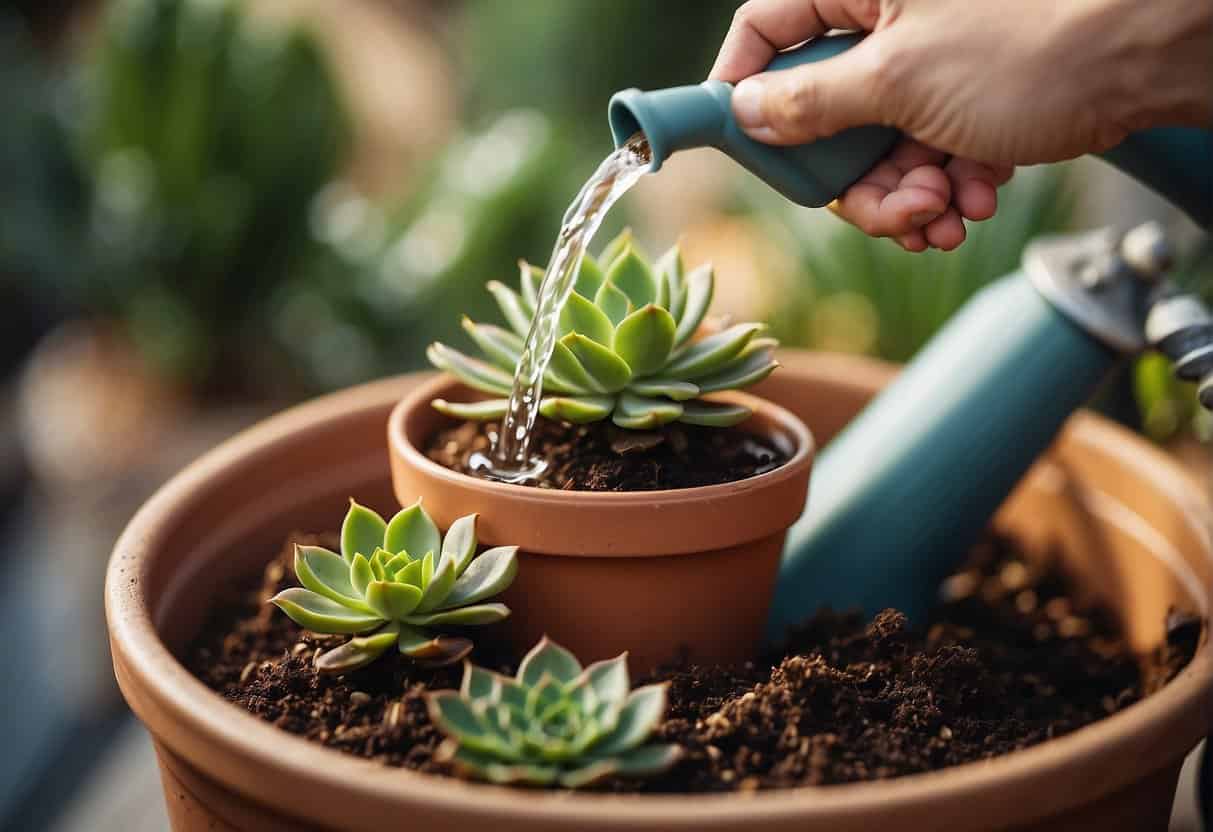
Proper watering is crucial for the health of succulents. These plants require a balance of moisture and dry periods, as too much or too little water can lead to issues like rot or drought stress. Understanding the specific water needs of your succulents helps them thrive.
Avoiding Overwatering and Underwatering
Overwatering is a common mistake with succulents. It can cause root rot and lead to a rapid decline in plant health.
To avoid overwatering, ensure that the soil is almost completely dry before adding more water. Use a pot with good drainage and a soil mix that doesn’t retain excess moisture.
Conversely, underwatering can lead to dehydration and may stunt a succulent’s growth.
While these plants are adapted to dry conditions, they still need sufficient moisture to survive.
It’s essential to provide a thorough watering that reaches the roots once the soil has dried.
How to Recognize Watering Needs
Succulents signal their watering needs through their leaves. A succulent needing water may have leaves that appear wrinkled or deflated, indicating it’s time to water.
When watering, it’s advisable to ensure the water reaches the root zone where it’s most needed.
Avoid using a spray bottle, which can lead to inadequate watering and increased humidity around the leaves, potentially leading to rot. Instead, a watering can can be used to apply water directly to the soil.
Remember that these care tips vary slightly depending on the specific type of succulent, as each species may have different moisture needs.
Light and Sunlight Exposure
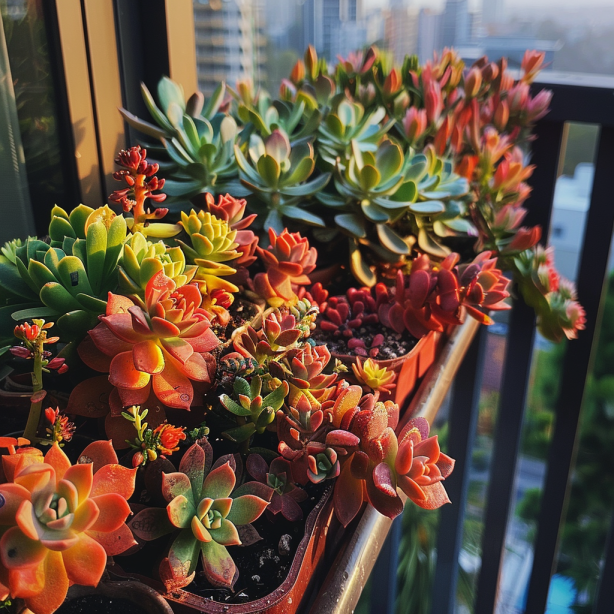
Proper light and sunlight exposure are critical for the health and growth of succulents.
These plants typically thrive in environments with plenty of light, but understanding the nuanced requirements for each species is key.
Finding the Right Balance of Light
Succulents need a delicate balance of light to maintain their vibrant colors and robust shape. Most varieties demand bright, indirect sunlight for the majority of the day.
Finding an indoor location that provides this consistent light can encourage healthy growth.
A sunny spot by a window, often one facing south or east, is ideal but must be monitored to ensure it doesn’t receive too much direct sunlight, which could lead to sunburn.
Dealing with Too Much or Too Little Sunlight
Too much sunlight, especially during the hottest part of the day, can scorch leaves and cause irreversible damage.
Conversely, insufficient light can lead to etiolation, where a succulent stretches toward the nearest light source and becomes weak.
If a plant begins to exhibit such signs, one must adjust its position or consider using grow lights as a supplementary light source.
It’s better to underwater your succulent than to expose it to excessive moisture, especially when recovering from light-related stress.
Potting and Repotting Techniques

When it comes to potting and repotting succulents, employing the correct techniques can significantly improve the health and appearance of these resilient plants.
By understanding the appropriate timing and procedures, gardeners can ensure that succulents develop sturdy roots and thrive in their environment.
The Best Time to Repot
Timing is critical when repotting succulents. They should be repotted during their active growth period, which is typically spring or early summer.
This allows the plant to recover and grow more efficiently after the transition. By contrast, repotting during dormancy can stress the succulent, leading to potential damage or slowed growth.
Step-by-Step Guide to Repotting
Preparation:
- Select a new pot: The new pot should be slightly larger—about 10-20%—than the current one and have adequate drainage holes.
- Choose the right soil: Use a well-draining succulent or cactus mix to prevent water retention, which can cause root rot.
Repotting Steps:
- Remove the succulent: Gently take the succulent out of its current pot. Be careful not to damage the roots. Then, shake off excess soil and inspect the roots for any signs of rot or disease.
- Trim if necessary: If any roots are dead or damaged, trim them away with clean, sharp scissors.
- Prepare the new pot: Fill the bottom of the new pot with a layer of soil mix.
- Position the succulent: Place the plant in the center of the pot and fill in around it with more soil. Leave about a half-inch of space at the top for watering.
- Water: Wait a few days before the first watering to allow any injured roots to heal. Then, water thoroughly.
Aftercare:
- Keep the repotted succulent in a bright, indirect light area. Resume regular watering once the plant has acclimated to its new pot.
Maintaining Plant Health

Maintaining the health of your succulents involves vigilance against pests and diseases, and proactive measures to prevent root rot. Succulents like aloe vera and various ferns require proper care to thrive.
Recognizing and Treating Common Pests and Diseases
Succulents can fall prey to a variety of pests, such as aphids, mealybugs, and spider mites. Misshapen leaves, a sticky residue, or visible insects often signal the presence of pests.
For aloe vera, which is particularly susceptible to scale insects, an effective treatment is wiping the leaves with rubbing alcohol or utilizing insecticidal soap.
Monitoring humidity levels is crucial. Excess moisture can encourage pest infestation and disease in many plant types, including ferns.
Preventing and Detecting Root Rot
Root rot is a common issue for succulents, often resulting from overwatering and poor drainage. To avoid this, ensure succulents are planted in well-draining soil and water is allowed to run out of the pot.
Detecting early signs of root rot involves checking for black or mushy roots and a general wilting of the plant.
If root rot is detected in aloe vera or ferns, remove the affected parts and repot the plant in fresh soil. It’s recommended to use containers with adequate drainage holes to prevent water accumulation.
Caring for Succulents in Different Seasons
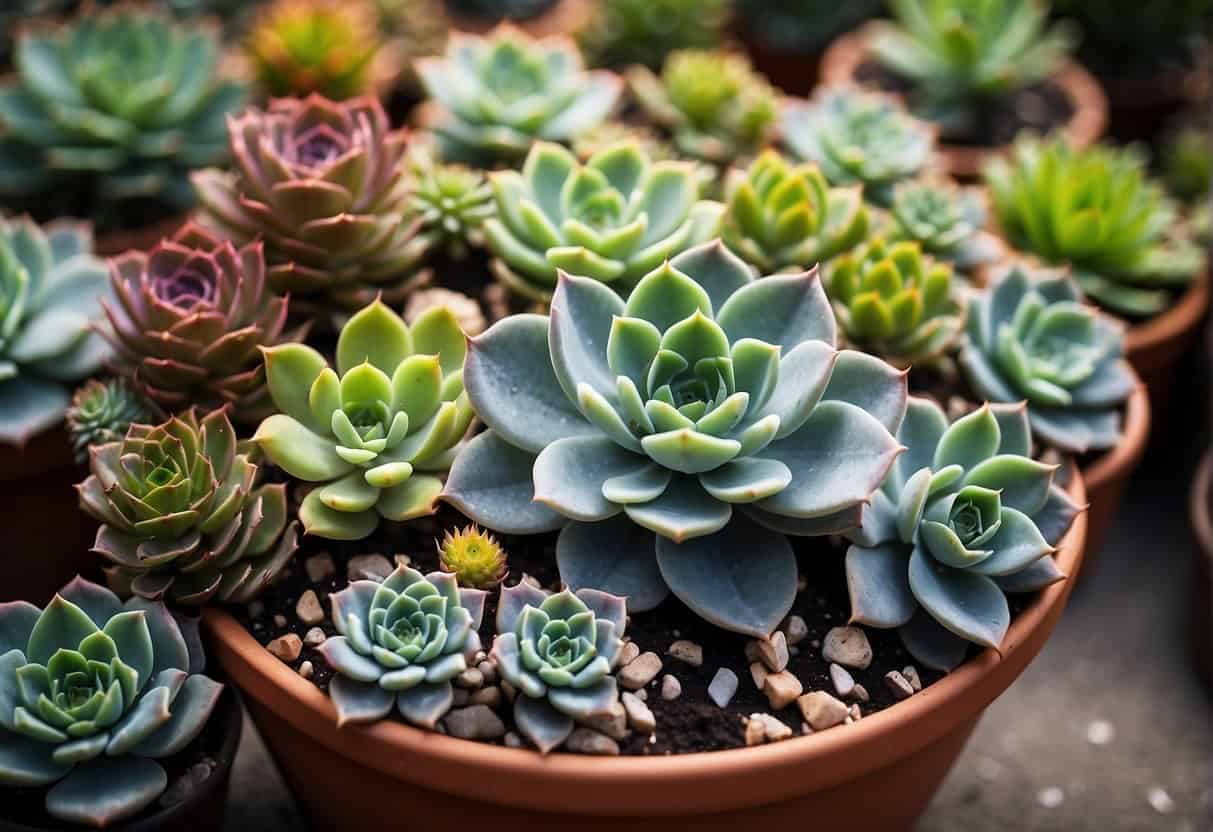
Properly caring for succulents requires an understanding of how seasonal changes affect these resilient plants. Attention to temperature variations and light exposure is crucial for their survival and growth throughout the year.
Summer and Winter Care Differences
In summer, succulents thrive in warm temperatures and longer daylight hours, making it their natural growing season. They often require more frequent watering to combat the intense heat, especially if they’re outdoor plants exposed to direct sunlight.
However, it’s essential to ensure adequate drainage to prevent overwatering and root rot.
Indoor succulents may need to be placed near windows to receive ample light, but one should avoid scorching sun that can cause sunburn to the leaves.
Conversely, winter presents a stark contrast as most succulents enter a period of dormancy due to lower temperatures and shorter days.
For succulents kept outdoors, moving them inside before the first frost is critical to protect them from cold damage.
Indoor succulents will benefit from being positioned in an area that receives bright, indirect light and reducing watering frequency as their growth slows down.
Some succulents may even flower during this dormant period if the conditions are suitable.
Adjusting Care During the Growing Season
The growing season for succulents typically aligns with the warmer months—spring to early fall. During this time, they actively grow and might even produce flowers.
Watering should align with the plant’s growth cycle: more water during active growth and less during dormancy. A good practice is the ‘soak and dry’ method, allowing the soil to completely dry before the next watering.
Succulents prefer temperatures between 70-80°F (21-27°C) but can tolerate a broader range as long as they are not exposed to frost.
Regular inspections for pests and making sure each plant has enough space to grow are other considerations during the growing season.
Outdoor succulents may require shade cloth to prevent sun damage during extreme heat, while indoor succulents may benefit from a diluted fertilizer to support their nutrition needs during this peak time of growth.
Advancing Your Propagation Skills

To excel in succulent propagation, understanding the specifics of each method and providing optimal care for new plants is crucial. These focused techniques will help increase success rates and avoid common issues such as root rot.
Methods for Propagating Succulents
Succulent propagation can be achieved through various methods, each requiring a nuanced approach to ensure success.
They can propagate through leaf cuttings, where leaves are gently twisted off the stem and left to callous before planting.
Stem cuttings involve cutting a piece of the stem with a sterile blade and similarly allowing it to heal before potting.
For both methods, it’s imperative to use a sharp, clean tool to prevent infection and ensure a healthy start for the cutting.
- Leaf Cuttings: Allow the leaves to dry and form a callous (1-2 days), then place on well-draining soil.
- Stem Cuttings: Cut a healthy stem, let it heal, and then plant it in a soil mix designed for succulents.
A key to avoiding root rot in these early stages is to ensure the cuttings are not overwatered and that the soil allows for proper drainage.
Caring for New Plants from Cuttings
Once succulents have been propagated, they require attentive care to thrive.
The newly planted cuttings should be kept in bright, indirect light and only watered once the soil has fully dried. They are susceptible to excessive moisture, which can lead to root rot, so it’s vital to monitor the watering schedule carefully.
Here are some clear steps to follow:
- Plant in well-draining soil.
- Avoid over-watering: Wait for the soil to dry out completely between watering cycles.
- Provide adequate light: Succulents need plenty of light, but direct sunlight can be too intense for new cuttings.
- Be patient: Rooting can take time, and it’s essential not to disturb the cuttings while they develop roots.
Balancing Nutrients and Fertilization
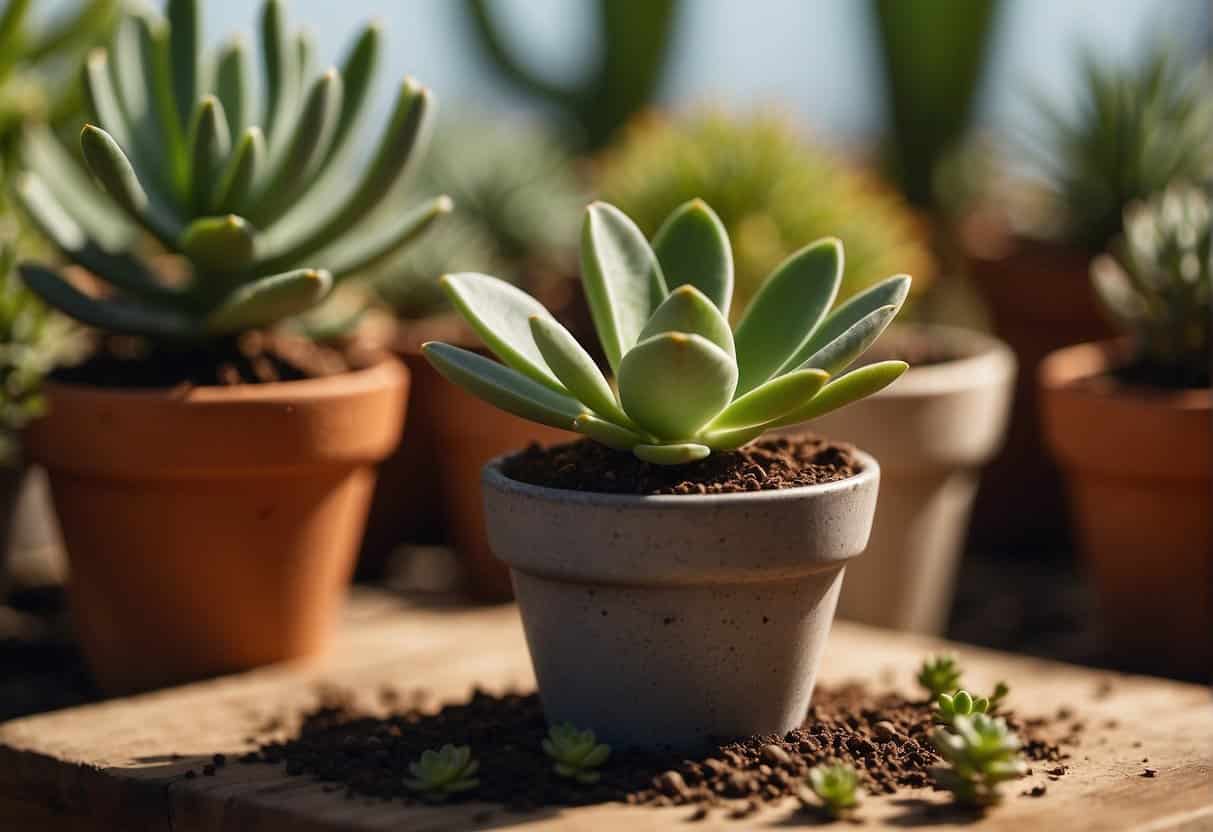
Properly balancing nutrients and fertilization is crucial in avoiding common potting mistakes with succulents. This involves understanding both when and how to furnish these plants with nutrients, and recognizing the specific roles key nutrients play in their health and growth.
When and How to Fertilize Succulents
Fertilizing succulents should be timed to match their growth cycles, typically during the growing season in spring and summer.
It is recommended to fertilize succulents lightly, as they require less fertilizer compared to other plants.
One can employ a balanced, water-soluble fertilizer once per month at half the strength indicated on the package instructions. Ensuring the correct frequency and concentration can prevent the common error of over-fertilization, which can harm succulent health.
- Frequency: Monthly during the growing season
- Concentration: Half-strength
- Application: Use a water-soluble fertilizer
Critical to the process is the type of water used; succulents prefer rainwater or distilled water when being fertilized to avoid excessive mineral buildup that can come from tap water.
Understanding the Role of Nitrogen and Other Nutrients
Nitrogen is a macronutrient that serves as a key component of chlorophyll, aiding in foliage growth.
However, because succulents are adapted to lean, arid environments, they need relatively lower levels of nitrogen. An overabundance can cause succulents to become leggy and weak.
- Nitrogen: Use sparingly to promote foliage growth
- Phosphorus: Encourages healthy root development and flowering
- Potassium: Enhances overall resilience and disease resistance
Soil conditions should be checked to ensure they have good drainage and do not retain excessive moisture, which can interfere with nutrient uptake.
A well-draining potting mix often provides adequate aeration and nutrient availability, allowing succulents to absorb what they need without the risk of root rot, which is a common issue when the soil stays too damp.
Design and Aesthetics

When potting succulents, the design and aesthetics are crucial for showcasing their unique beauty. The right pot and arrangement can elevate the plant’s appearance, making it a focal point in any room.
Selecting Pots That Complement Your Succulents
The choice of pot is pivotal in exhibiting the distinct qualities of your succulents.
Small pots are often preferred for single succulents, ensuring they don’t get lost in an overbearing container. Conversely, larger succulents require pots that provide adequate space without crowding the plant.
When considering materials, terra cotta and ceramics with drainage holes are excellent as they facilitate proper moisture management, crucial for succulent health.
Arranging Succulents for Visual Appeal
To create an engaging display, arrange succulents of various sizes and textures together. Incorporating elements like rocks, gravel, or moss adds depth and mimics natural landscapes.
Remove any dead leaves to maintain a tidy appearance.
Consider a topdressing of rocks or sand to complete the aesthetic while also aiding in soil moisture retention.
When arranging groups, play with height and color contrasts to draw the eye and keep the arrangement visually balanced.
Final Tips for Novice Gardeners
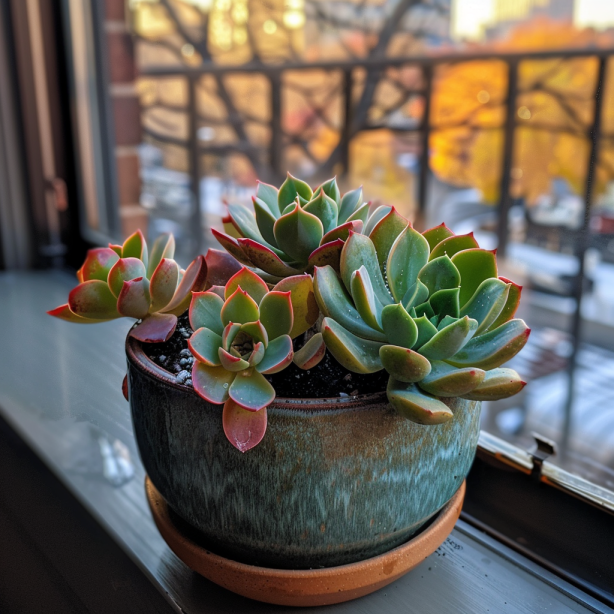
Novice gardeners embarking on the journey of succulent care should prioritize simplicity. Succulents are renowned for being low-maintenance, but they do require specific attention to thrive. Here are some key tips to keep in mind:
- Light: Ensure succulents receive ample light to prevent them from becoming leggy—stretched out due to insufficient light. If natural light is limited, consider grow lights.
- Watering Techniques: Overwatering is a common pitfall. Succulents should be watered thoroughly, yet infrequently, allowing the soil to dry out between waterings.
- Proper Soil: Use a well-draining soil mix specially formulated for cacti and succulents to enhance drainage and prevent root rot.
- Containers: Pots with drainage holes are ideal. Without a hole, water can accumulate, leading to overwatering issues.
Here is a quick reference for common tasks and considerations:
| Task | Details |
|---|---|
| Watering Frequency | Water less in winter; check the top inch of soil for dryness. |
| Misting | Generally, avoid misting; succulents prefer a dry environment. |
| Light Exposure | Rotate succulents for even light distribution and to avoid legginess. |
| Pot Selection | Choose pots with drainage holes to avoid waterlogging. |
By incorporating these techniques, beginners can confidently care for their succulents and enjoy the gratifying experience of nurturing these unique plants.
Frequently Asked Questions
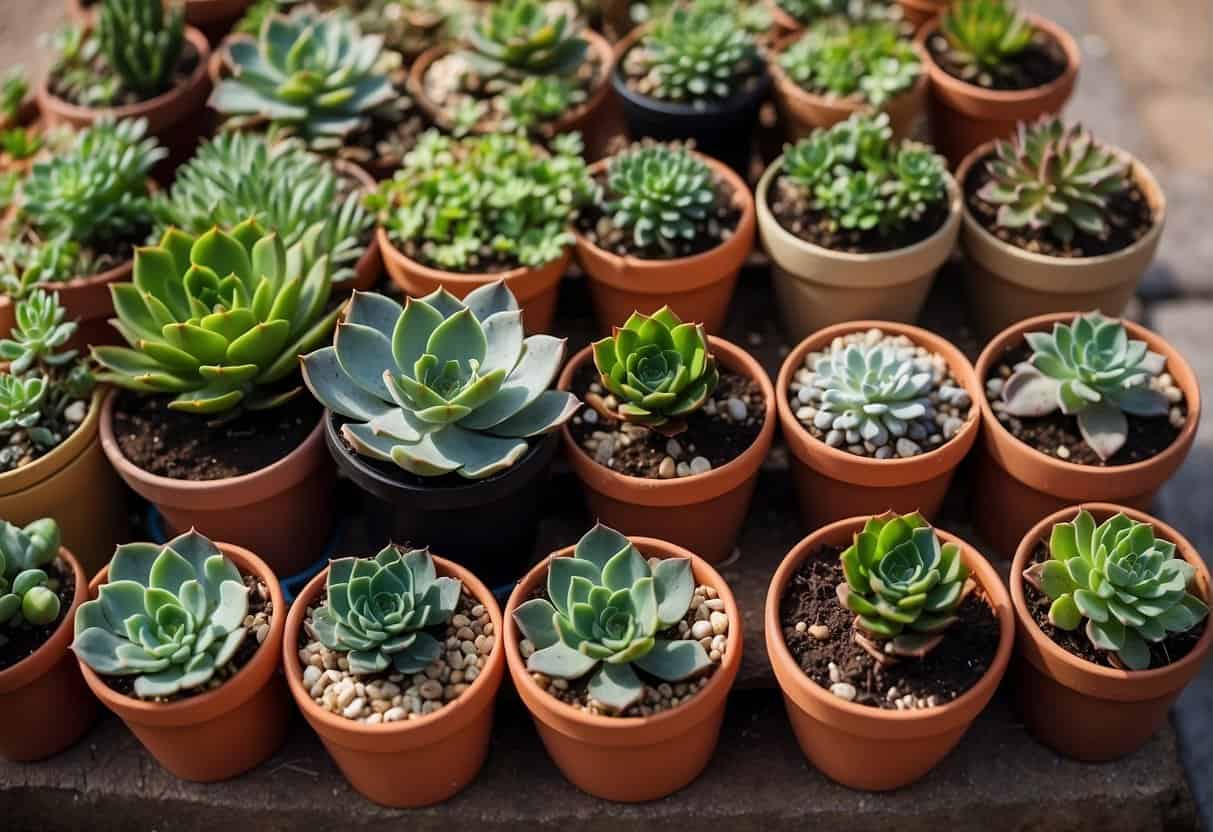
Before diving into the details, it’s crucial for beginners to understand common mistakes when potting succulents — from drainage considerations to watering frequency. These FAQs shed light on good succulent care practices.
Why is proper drainage essential for succulent health?
Proper drainage is vital to prevent root rot, which succulents are prone to in soggy soil. Drainage holes allow excess water to escape, ensuring that the roots are not immersed in water.
How does overwatering affect succulent plants?
Overwatering is the leading cause of succulent failure. It leads to root rot and fungal diseases, as succulents store water in their leaves and do not require frequent watering. Learning about watering needs is critical for their care.
What type of soil composition is best suited for succulents?
Succulents need well-draining soil that mimics their natural arid environments. A mixture of potting soil with sand or perlite provides the appropriate soil composition for healthy growth.
How often should succulents be watered?
Watering frequency depends on the environment, but a general rule is to water succulents deeply when the soil feels dry to the touch. It is less about how often and more about how thoroughly they are watered, promoting healthy root growth.
Can succulents thrive in low-light environments?
While succulents prefer bright light, some can survive in low-light environments. However, their growth may be hindered, and they might not display their vibrant colors without sufficient lighting.
What are the consequences of using a pot that’s too large for a succulent?
A pot that’s too large holds more soil, which retains more water. This can lead to overwatering and root rot. This happens because the succulent’s roots are not extensive enough to absorb all the moisture in the soil.

